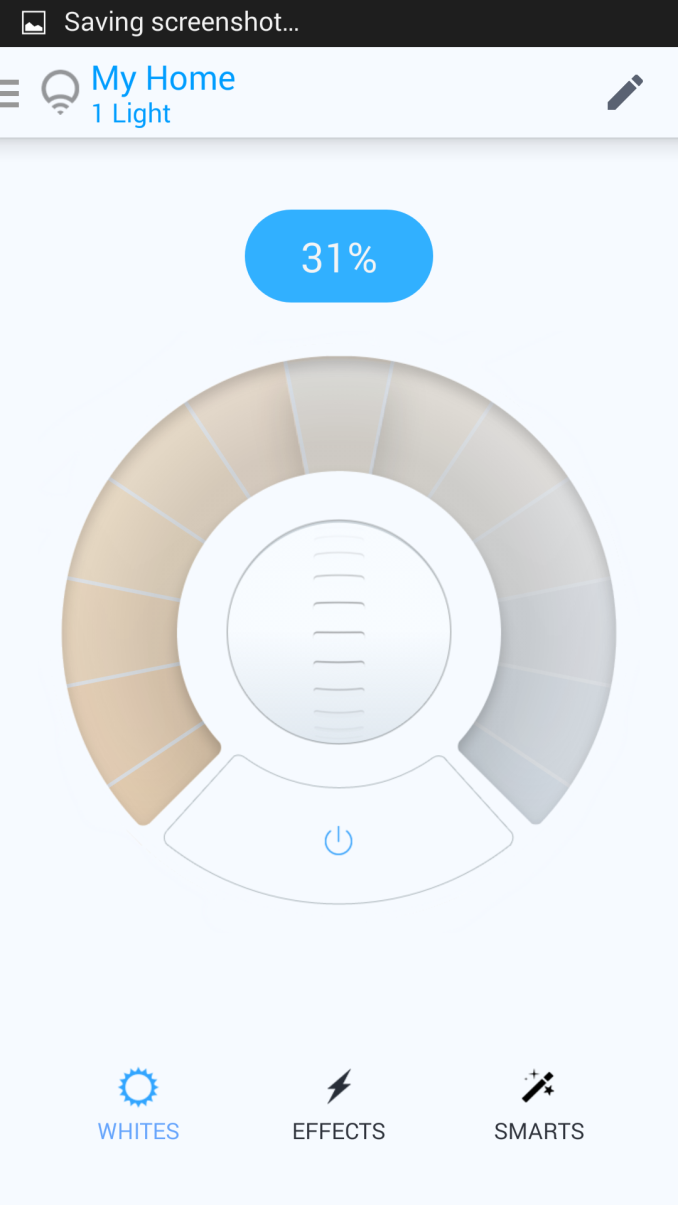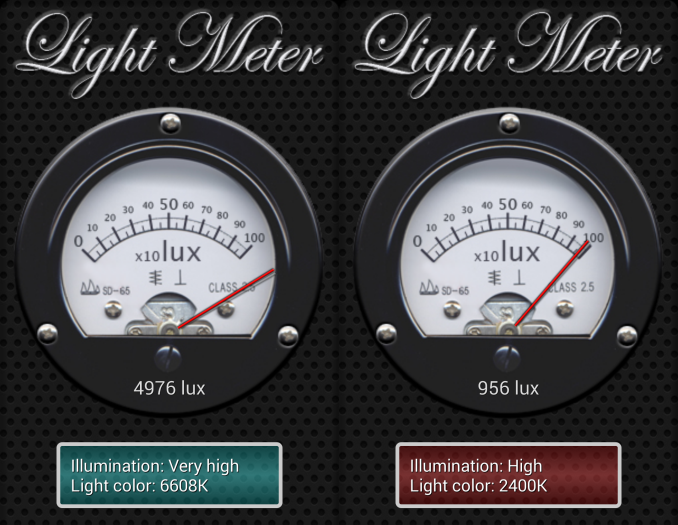LIFX White 800 Smart Bulb Review
by Ganesh T S on June 12, 2015 9:55 AM EST- Posted in
- Home Automation
- Wi-Fi
- Qualcomm Atheros
- LIFX
Setup, Usage and APIs
The setup process for the LIFX White 800 is similar to most other IoT devices. The unit boots up with its own SSID. A mobile device (iOS or Android) with the LIFX app pre-installed is made to connect to it. A LIFX account is associated with the device. It enables control over Internet with communication via LIFX's servers.
Dimming is achieved via the core thumb-wheel in the app's home page. Color temperature can be tuned using the dial around it.
Many of the other app features such as themes are applicable to the multi-colored light bulbs. However, the scheduling feature works well with the White 800.
On the whole, the app is straightforward and easy to use.
We measured color temperature of the light bulb's out with a Samsung Galaxy S4 using a Light Meter app. The color temperature dial in the LIFX app was set to the two extreme temperature points for the screenshots below.
The color temperature measured as per the specifications and was obviously evident to the naked eye.
LIFX has been quite popular with power users. The communication protocol was reverse engineered, and there are multiple open source projects based on them. lifx-http, lifxjs and lifx-java are examples. Firmware v2.00 messed up many of these apps. However, it also brought along support for the official HTTP APIs. The APIs are a very good starting point and allow simple apps, but, unfortunately relies on the LIFX's web servers being up and the user's Internet connection being active (it is cloud-only). Recently, the official LAN-only documentation was updated. Hopefully, local HTTP APIs are made available soon - either officially from LIFX or via third-party developers.
Initially, LIFX didn't appear power-user friendly after the launch of v2.00 of the firmware, but things are slowly getting better with the publishing of the LAN protocol. The main item in our wishlist with respect to usage / APIs is a web interface for the bulb - the ability to control the light temperature and brightness using a web browser. This interface could also double up as an official 'mobile app' for platforms such as Windows Mobile.
























55 Comments
View All Comments
jjj - Friday, June 12, 2015 - link
I hate it when the term"smart"gets abused like this. Unless there is something smart about it and you failed to mention it, this is just a connected bulb. If it could at least auto-adjust brightness and be able to detect people ,then maybe it could be called smart.Why does everybody wants to screw the user by injecting themselves in the middle. Sure not a huge problem here like with locks but they really need to stop it with their own servers.
And 40$ for a bulb is beyond outrageous , when normal LED bulbs cost a few times less and they are seen as very expensive anyway, you can't do this and pretend the product is viable.
Then on the software side you can't have an app for every connected device in a home and for now that's a mess.
I get it that it's new and cool so you get carried away but the thing speaks volumes about the state of IoT. Poorly thought, poorly executed ,dumb and overpriced. Not that it's easy to do better given the mess when it comes to standards, software and even the less than optimal silicon solutions but it feels likely people can't even be bothered to try.
I guess being able to rent one (lol) would be useful if you aren't sure what temperature to buy so you just test a few and then go buy a normal bulb.
name99 - Friday, June 12, 2015 - link
I'm a little curious as to WTF their app thinks it's doing. Is this standard for Android?They want
- location. OK, that's a reasonable use case for on/off geo-fencing when I enter/leave the house.
- WiFi connection info? Why? Is this so the app can say "I can't find the lightbulb on WiFi network X, try another network?" I'd have thought
[a] the way to set this up properly is to bring Bluetooth or NFC into the mix. That's the way the most modern user-friendly set-ups for these devices are going.
it's the job of the OS to tell the user the WiFi network and ask for that to be changed. Having apps do this seems both broken in terms of UI+functionality and one more damn thing that should not be the app's business.
- Identity. Why?
- camera/microphone/photos? WTF????
name99 - Friday, June 12, 2015 - link
sorry, didn't mean to bold the above. Didn't realize your markup would interpret [ b ] that way.zepi - Friday, June 12, 2015 - link
At least philips hue supports functions like "make the my lights mimic the colors of this image / whatever comes from camera" and some 3rd party apps also control the lights to the beat of the music that is being played.And hues are slow compared to lifx, which probably would even work nicely as a color strobe at the party (the fancy RGB version).
fic2 - Friday, June 12, 2015 - link
Downloaded the Light Meter app to check my cheap ($2) LED bulb temps. They say they are 2700K but look closer to 3000K to me. Which is great since I would rather have 3000K temp. I wish stores would stock different temp bulbs though.fic2 - Friday, June 12, 2015 - link
I would love to change light temps on my bulbs but for a $38 difference in bulb price I'll stay with one temp. Maybe in 5-10 years these will be cheap.jonsmirl - Friday, June 12, 2015 - link
What did they use for an AC power supply chip?mkozakewich - Friday, June 12, 2015 - link
I wish we'd move entirely away from colour temperature. Black-body radiators are kind of restrictive. I'd prefer to be able to select from RGB or something. Maybe some time I'll want a sunset purple. Usually I want something very close to white, except with more yellow. Pantone lightbulbs!Also, it shouldn't be hard to make 1600-lumen bulbs, now. I remember hearing about LEDs with 200-lumens-per-watt efficacy back in 2009, but they still don't seem to be delivering. I've got a Philips bulb that uses nine ultraviolet LEDs under fluorescing panels, but it's still 12.5 Watts for 800 lumens (64 lumens/Watt or 88 lumens per LED).
Those 'corncob' lights are interesting. Check this out: http://www.renesola.ca/renesola-20w-led-corn-light...
By the nature of arrays, they go up to 100 W or more.
melgross - Saturday, June 13, 2015 - link
The multiple LED bulbs, such as the corncobs, are the least efficient, as they use older LEDs. Cree has bulbs that are from 85-100 lumens/watt. Next year, we'll see over 100. There has never been a 200 lumen/watt LED out of the lab.Coldsnap - Friday, June 12, 2015 - link
This is actually pretty exciting. The dream is to have the full house setup with smart bulbs that can change the color temp automatically throughout the day to mimic what the sun is actually putting off temp wise. This would actually make a BIG difference in energy during the day and sleep quality, if you are the type who is in doors most the day.